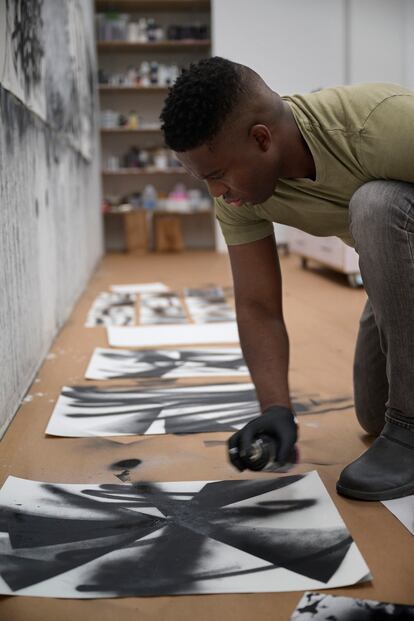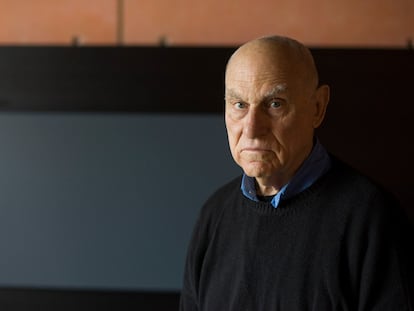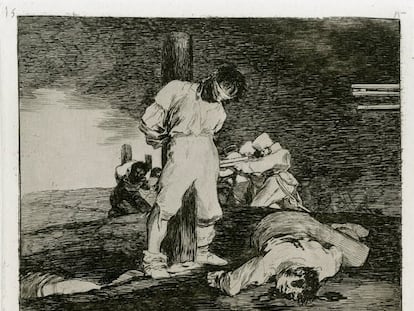Adam Pendleton: ‘Nina Simone allows us to think of my country’s culture as a complex and inclusive place, rather than a simple and exclusionary one’
Abstract at a time of a figurative boom, an activist but not overtly political, the American artist is exhibiting his black and white canvases at the Madrid headquarters of the Pedro Cera gallery

“I don’t usually think about what’s trendy,” says Adam Pendleton. The 40-year-old from Richmond in the U.S. is not an easy artist, in any sense. He staunchly extols practices as demanding as conceptual and abstraction in the face of the current boom in figurative painting, led by some of the most successful African-American artists in the market, with Kehinde Wiley or Kara Walker among the finest exponents. Perhaps in that same orbit he would obtain more lucrative results, but that is not what interests him. “I just don’t think of my work in those terms,” he says in the spacious showroom of the Madrid headquarters of the Pedro Cera gallery, where he is staging an exhibition together with his compatriot, sculptor Arlene Sechet (Adam Pendleton X Arlene Sechet, through April 13).
His artistic roots are in the historical avant-gardes of more than a century ago and his themes, treated in a complex and occasionally somewhat elusive manner, are an amalgam in which identity and the individual as a political subject converge, but also culture and collective memory. “My goal is to create a space for my work, and for that permanent faith in it is required,” he says. “Not a rigid faith, but one that is open to experimentation.”

His contribution to the Madrid show is paintings and drawings that rarely abandon black and white, and when they do it is to introduce notes of intense but subtle tones, which serve to underline even more the restrictiveness of his formal universe, and which dialogue harmoniously with Sechet’s colorful and dynamic sculptures. It has often been suggested that the black and white of his images are an abstract reflection of the confrontation between these colors in purely racial terms. But, in conversation, he prefers not to encourage interpretations of political symbolism and instead claims purely formal motives. “I simply use the materials and colors needed at any given moment,” he explains. “Color can be amazing, but I think the look becomes more profound when there is no such interference.”
The same is true when the political situation in the United States, marked by the new rise of Donald Trump, comes up. “Can I ask why you’re asking me that?” he inquires, softening the defensive reaction with a laugh.
— Because from outside the U.S. there is a certain fascination with the figure of Trump, which is mixed with a sense of dread. Asking American intellectuals like you about this is an attempt to understand him.
— Ah okay. I want to acknowledge reality and its situations, but not be distracted by them. I think in the end it’s important to focus on the work, because that can be a very relevant way to position yourself as an individual. I guess I ask myself: ‘Do I want to represent America?’ I’m not really interested in that. If I was, I’d be a politician instead of an artist.
— Returning then to the work, how do you explain the use of black in it?
— Painting is a very material space, and that’s a decision I don’t take lightly. Black is the union of all colors. There is something essential in it, something very deep.
Depth is something Pendleton returns to again and again. While the culture of spectacle, which has shown itself to be omnipresent in the visual arts as well, rather seems to advise superficial and flashy approaches to any given question, he pursues very different ends: “I look for the possibilities of a deep gaze, a deep experience, and deep thought. I’ve always been fascinated by how certain art manages to hold people’s attention over time, how for hundreds of years we can be looking at the same paintings or listening to the same music. So I see myself more as an artist contributing to a very long history.”
This has not prevented Pendleton from forging a career of precocious and brilliant success. At 18, just out of high school, he traveled to Pietrasanta in northern Italy (famous for its quarry where Michelangelo sought the marble for his sculptures) to follow an artistic residency program; at 26 he staged a large installation in a group exhibition at the PS1 space at New York’s MoMA; and at 28 he became the youngest artist on the payroll of the powerful multinational gallery Pace. Shortly before that he had given shape to his most ambitious project: his own artistic movement, called Black Dada, a name taken from a 1964 poem by the writer Amiri Baraka, a pillar of Afro-American culture. Although the exact formulation of the meaning of Black Dada is rather enigmatic, it has been defined as mining the interrelations between blackness, avant-garde, and abstraction. “Things are not always clear and perfect, there are also incongruous ideas,” Pendleton says. “And that’s fine, because there has to be conflict and generative chaos, which I think is very important in art.”
In 2021 he presented perhaps his most ambitious exhibition to date, Who Is Queen? a kind of total work in the form of an installation that incorporated references to the history of modern art and architecture and texts of diverse origins in drawings, paintings, sculptures, and videos, and where his identity as an African-American gay man was reflected in complex and multiform ways. The title itself held a mysterious quality that suggested all manner of interpretations. “It touches on this idea of the relationship between how you want to be interpreted and understood, and how that relates to how you’re actually interpreted and understood, because often the two don’t coincide,” he explains. “It refers back to how the word queen is used in queer spaces. It’s a title that is a question, so it was about meditating on those ideas, about representation, and how it relates to abstraction. Because we all exist in an abstract state. And as an artist I feel driven by notions of abstract thinking and composition as well.” He would return to this idea with a major solo exhibition at the Mumok Museum in Vienna, Blackness, White and Light, which closed in January.
As an activist, he transcends his work: last year he teamed up with Sotheby’s, tennis player Venus Williams and a group of artists including Rashid Johnson, Julie Mehretu, and Ellen Gallagher — “there’s nothing like the generosity of artists,” he says — to organize an auction that would allow them to acquire singer Nina Simone’s birthplace and preserve it as a material vestige of American culture. “Nina Simone represents something of crucial importance, which allows us to think of my country’s culture as a complex and inclusive place, rather than a simple and exclusionary one,” he says. “We must be custodians of our present and our future.”
Sign up for our weekly newsletter to get more English-language news coverage from EL PAÍS USA Edition
Tu suscripción se está usando en otro dispositivo
¿Quieres añadir otro usuario a tu suscripción?
Si continúas leyendo en este dispositivo, no se podrá leer en el otro.
FlechaTu suscripción se está usando en otro dispositivo y solo puedes acceder a EL PAÍS desde un dispositivo a la vez.
Si quieres compartir tu cuenta, cambia tu suscripción a la modalidad Premium, así podrás añadir otro usuario. Cada uno accederá con su propia cuenta de email, lo que os permitirá personalizar vuestra experiencia en EL PAÍS.
¿Tienes una suscripción de empresa? Accede aquí para contratar más cuentas.
En el caso de no saber quién está usando tu cuenta, te recomendamos cambiar tu contraseña aquí.
Si decides continuar compartiendo tu cuenta, este mensaje se mostrará en tu dispositivo y en el de la otra persona que está usando tu cuenta de forma indefinida, afectando a tu experiencia de lectura. Puedes consultar aquí los términos y condiciones de la suscripción digital.
More information
Archived In
Últimas noticias
Most viewed
- Alain Aspect, Nobel laureate in physics: ‘Einstein was so smart that he would have had to recognize quantum entanglement’
- Mexico’s missing people crisis casts a shadow over World Cup venue
- Why oil has been at the center of Venezuela-US conflicts for decades
- Trump clarifies who is ultimately in charge in Venezuela: ‘Me’
- Mexico seeks to shore up its defenses following US incursion in Venezuela











































